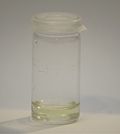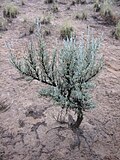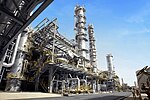Isoprene, or 2-methyl-1,3-butadiene, is a common volatile organic compound with the formula CH2=C(CH3)−CH=CH2. In its pure form it is a colorless volatile...
18 KB (1,884 words) - 12:26, 6 February 2025
Terpene (redirect from Isoprene rule)
solids. Conceptually derived from isoprenes, the structures and formulas of terpenes follow the biogenetic isoprene rule or the C5 rule, as described...
32 KB (3,491 words) - 12:31, 4 January 2025
The enzyme isoprene synthase (EC 4.2.3.27) catalyzes the chemical reaction prenyl pyrophosphate ⇌ {\displaystyle \rightleftharpoons } isoprene + diphosphate...
4 KB (479 words) - 14:37, 26 August 2023
naturally occurring organic chemicals derived from the 5-carbon compound isoprene and its derivatives called terpenes, diterpenes, etc. While sometimes used...
11 KB (913 words) - 19:44, 24 October 2024
without decomposition, although at elevated temperatures it cracks to form isoprene. It oxidizes easily in moist air to produce carveol, carvone, and limonene...
20 KB (1,584 words) - 18:09, 14 January 2025
synthetic rubber, a copolymer of isobutylene with isoprene. The abbreviation IIR stands for isobutylene isoprene rubber. Polyisobutylene, also known as "PIB"...
13 KB (1,522 words) - 14:41, 30 August 2024
caoutchouc, as initially produced, consists of polymers of the organic compound isoprene, with minor impurities of other organic compounds. Types of polyisoprene...
61 KB (7,051 words) - 09:52, 8 February 2025
which are terpenoids (isoprenoids), synthesized biochemically from eight isoprene units and thus having 40 carbons. Dietary β-carotene is a provitamin A...
34 KB (3,540 words) - 02:03, 12 January 2025
Sesquiterpenes are a class of terpenes that consist of three isoprene units and often have the molecular formula C15H24. Like monoterpenes, sesquiterpenes...
7 KB (704 words) - 19:09, 18 November 2024
of isoprene. In practice polyisoprene is commonly used to refer to synthetic cis-1,4-polyisoprene, made by the industrial polymerisation of isoprene. Natural...
5 KB (502 words) - 19:27, 10 July 2024
distinct types of biochemical subunits or "building-blocks": ketoacyl and isoprene groups. Using this approach, lipids may be divided into eight categories:...
71 KB (7,366 words) - 17:09, 19 January 2025
are derivatives of tetraterpenes, meaning that they are produced from 8 isoprene units and contain 40 carbon atoms. In general, carotenoids absorb wavelengths...
44 KB (5,282 words) - 02:45, 2 November 2024
Triterpenes are a class of terpenes composed of six isoprene units with the molecular formula C30H48; they may also be thought of as consisting of three...
5 KB (509 words) - 14:51, 30 April 2023
and trans-1,4-polyisoprene gutta-percha Synthetic polyisoprene (IR for isoprene rubber) Polybutadiene (BR for butadiene rubber) Chloroprene rubber (CR)...
10 KB (972 words) - 09:26, 24 January 2025
Prenylated proteins are proteins with covalently attached hydrophobic isoprene polymers (i.e. branched five-carbon hydrocarbon) at cysteine residues of...
20 KB (2,232 words) - 07:44, 22 June 2024
chains have chain lengths of C10, C15, C20 etc. since they are derived from isoprene units. These chains are branched, with one methyl substituent per C5 subunit...
18 KB (2,269 words) - 01:56, 30 June 2024
Monoterpenes are a class of terpenes that consist of two isoprene units and have the molecular formula C10H16. Monoterpenes may be linear (acyclic) or...
16 KB (1,634 words) - 02:46, 23 August 2024
isobutylene, isoprene, chloroprene; elastomeric polymers are often made with a high percentage of conjugated diene monomers such as 1,3-butadiene, isoprene, or...
20 KB (2,104 words) - 09:53, 19 January 2025
Methacrylonitrile (redirect from Isoprene cyanide)
Methacrylonitrile (or 2-Methylprop-2-enenitrile), MeAN in short, is a chemical compound that is an unsaturated aliphatic nitrile, widely used in the preparation...
13 KB (1,696 words) - 17:38, 5 September 2022
Oak trees produce a haze of isoprene, which helps give the Blue Ridge Mountains their signature color....
281 KB (24,684 words) - 05:26, 12 February 2025
the Bayer laboratory in Elberfeld, Germany, succeeded in polymerizing isoprene, making the first synthetic rubber. Studies published in 1930 written independently...
10 KB (1,181 words) - 01:29, 2 January 2025
when seen from a distance. Trees put the "blue" in Blue Ridge, from the isoprene released into the atmosphere. This contributes to the characteristic haze...
18 KB (1,574 words) - 05:47, 12 January 2025
(abbreviated MK-4) has four isoprene residues in its side chain. Menaquinone-4 (also known as menatetrenone from its four isoprene residues) is the most common...
31 KB (3,649 words) - 22:59, 17 January 2025
v t e Types of terpenes and terpenoids (# of isoprene units) Basic forms: Acyclic (linear, cis and trans forms) Monocyclic (single ring) Bicyclic (2 rings)...
41 KB (4,178 words) - 19:17, 11 February 2025
from six to ten subunits in the tail, with humans having a tail of 10 isoprene units (50 carbon atoms) connected to its benzoquinone "head". This family...
49 KB (4,883 words) - 08:01, 4 February 2025
C5H6O. It is formed from the gas-phase reaction of hydroxyl radical with isoprene. In mice, it is toxic by inhalation. 2-Methylfuran Atkinson, Roger; Sara...
2 KB (121 words) - 08:49, 2 September 2024
thermoplastic, most commonly sourced from Palaquium gutta; it is a polymer of isoprene which forms a rubber-like elastomer. The word "gutta-percha" comes from...
16 KB (1,730 words) - 17:28, 20 January 2025
important reaction that uses these activated isoprene donors is sterol biosynthesis. Here, the isoprene units are joined to make squalene and then folded...
113 KB (12,371 words) - 16:51, 16 December 2024
terpene hydrocarbons. Terpenes in turn are formally made up of five-carbon isoprene units (The alternate steroid base is a terpene missing a few carbon atoms)...
22 KB (2,249 words) - 20:30, 21 January 2025





















